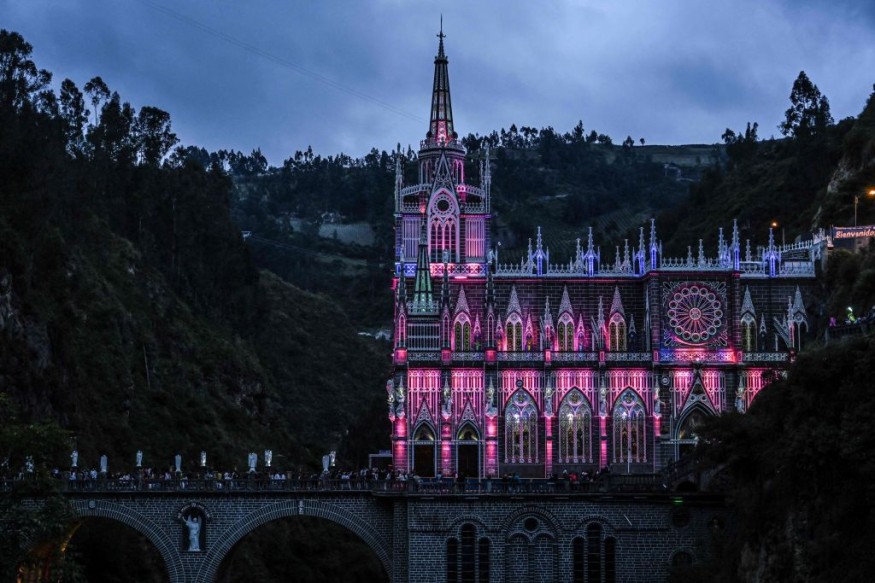Colombia: 5 Famous Religious Sites to Visit

Roman Catholicism is the most dominant religion in Colombia. Around 84% of Colombians were baptized in the Catholic Church, and they were raised believing in God.
Spanish colonists introduced the faith in the 14th century, and it has since been embedded in Colombian culture and society, according to Cultural Atlas.
With the growth of Roman Catholicism in Colombia comes the historical artifacts and sacred places that adhere to the faith, such as the Minor Basilica of the Lord Miracles.
The sanctuary, founded on August 2, 1907, is located in Buga municipality in Valle del Cauca Department.
The Valle del Cauca also houses other Catholic architectural grounds, such as the Cathedral of San Pedro de Buga, the Church of Santo Domingo de Guzman, and the Church of San Francisco de Asis.
Even non-religious visitors can enjoy wandering Colombia's religious sites, considering its rich history, dramatic settings, and architectural grandeur.
READ NEXT : Religious Pilgrimage in Latin America: Famous Sacred Sites in Brazil to Add to Your Travel List
Colombia: Famous Sacred Sites to Visit
Another sacred location that has become popular with Catholics and non-Catholics is the Las Lajas Sanctuary.
One of the place's most distinct characteristics is the fact it was built over a Colombian gorge on the border between Colombia and Ecuador.
Las Lajas Sanctuary has a certain charm attached to a legend that continues to mystify visitors. According to Atlas Obscura, the legend tells a story of an Amerindian woman and her daughter caught in a storm in 1754.
As they hid from the stormy weather in the gorge, the women looked up and saw the image of the Virgin Mary on the rocks above. Upon seeing the figure, the woman's daughter was then cured of her inability to hear and speak.
The minor basilica sits atop the river below, with a height of 150 feet. The green cliffs and waterfalls are visible from the arched stone bridge.
Virgen Rosa Mística
In Medellin, Colombia, even criminals have a sacred ground they consider visiting whenever they need comfort.
The Virgen Rosa Mística, or the Virgin of the Mystic Rose, is believed to have been created by a wealthy drug kingpin.
It was reportedly a popular destination for the infamous Colombian drug kingpin Pablo Escobar, and he would pray there.
Escobar allegedly built the shire from the rubble to express his gratitude. The shrine is referred to as "Virgin of the Sicarrios," meaning "Virgin of the Assassins."
Convento de la Popa
The Convento de la Popa, which translates to "Convent of the Stern," was founded by Augustinian fathers in 1607. It was first a small wooden chapel but was later fortified with thicker construction materials, according to Lonely Planet.
Legend tells the story that some locals used to worship an evil spirit in the shape of a goat that lived on top of the hill that the abbey would soon stand atop.
It was believed that the friar successfully brought Christianity to the land when the convent was established.
In the early 19th century, Augustinian friars were forced to leave the abbey after the Colombian Declaration of Independence. It gained control of the place in 1961.
San Pedro Claver Museum and Cloisters
The Cloister of San Pedro Claver in Cartagena imprinted an important cultural mark due to its connection to San Pedro Claver, who is known to be the first person to be canonized in the New World.
Claver was known to have dedicated his life to taking care of the enslaved from the moment they arrived in the Americas.
Aside from its story, the cloister captures the attention of its visitors with its "Baroque ecclesiastical" architectural design, according to World Monuments Fund.
Cathedral of Salt
NPR reported that the salt cathedral is one of the most famous churches in Colombia. It is located about 600 feet underground and stands in a former salt mine in Zipaquirá.
Before reaching its popularity, the cathedral was previously a small sanctuary, where miners would pray to the Virgin of the Rosary of Guasa, the patron saint of miners, asking for protection.
The old mining site was then converted into a church in 1953 after several calls from the miners, church officials, and other influential figures.
This article is owned by Latin Post.
Written by: Mary Webber
WATCH: Top 10 Beautiful Places to Visit in Colombia - Colombia Travel Video - From Top 10 Places
Subscribe to Latin Post!
Sign up for our free newsletter for the Latest coverage!

















